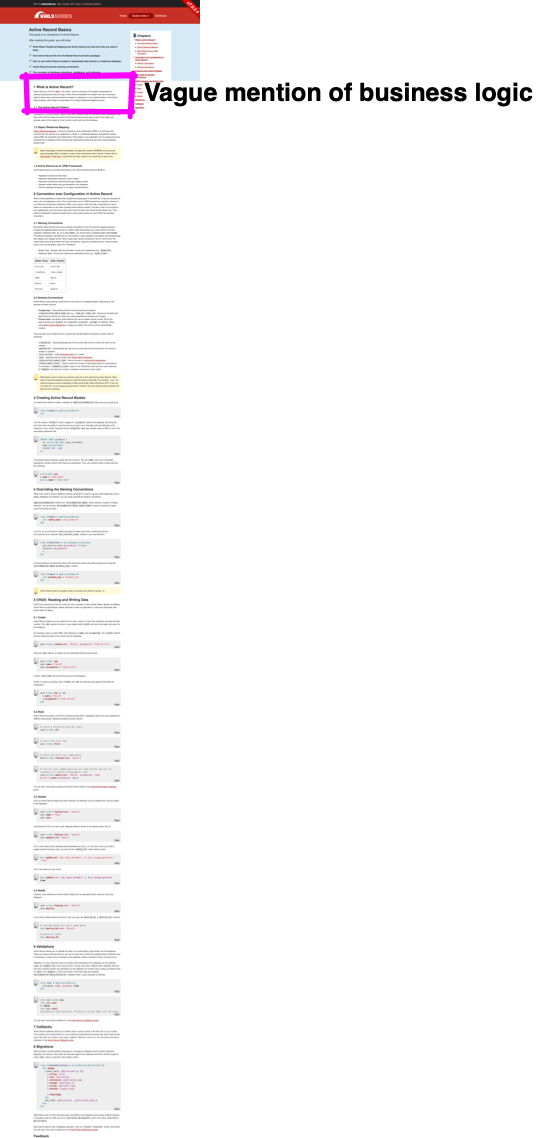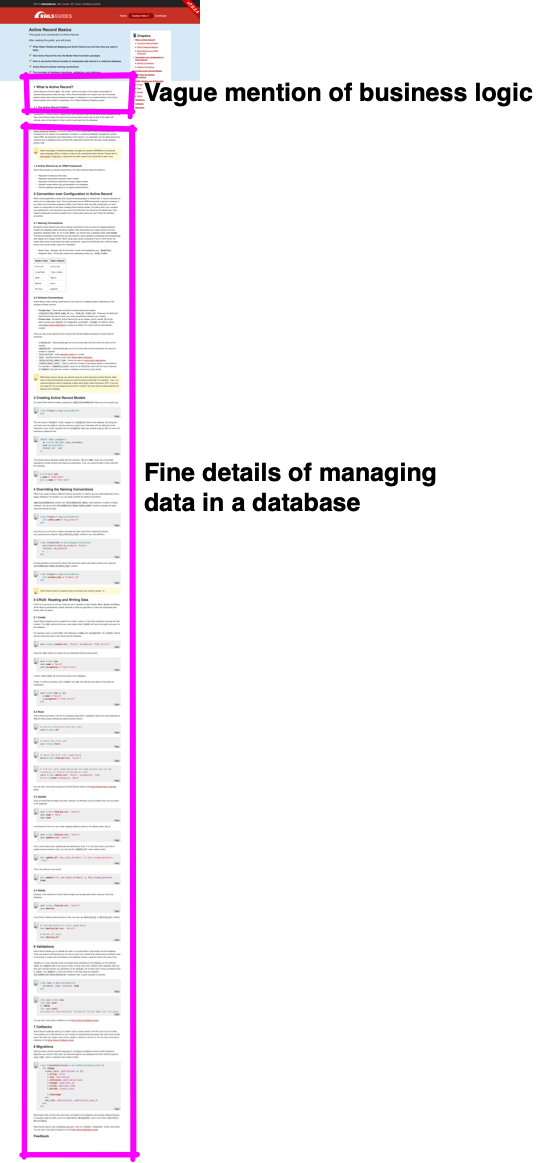Your Service Layer
Needn't be Fancy,
It Just Needs to Exist
David Copeland (he/him)
CTO, Mood Health
class Widget < ApplicationRecord
belongs_to :manufacturer
validates :price,
numericality: { greater_than: 0 }
end
class WidgetsController < ApplicationController
def create
@widget = Widget.new(widget_params)
if @widget.save
redirect_to widgets_path
else
render :new
end
end
end
class WidgetsController < ApplicationController
def create
@widget = Widget.new(widget_params)
if @widget.save
PreOrderJob.perform_later(@widget.id)
redirect_to widgets_path
else
render :new
end
end
end
class WidgetsController < ApplicationController
def create
@widget = Widget.new(widget_params)
if @widget.save
if @widget.price > 1_000
AdminMailer.new_widget(@widget)
else
PreOrderJob.perform_later(@widget.id)
end
redirect_to widgets_path
else
render :new
end
end
end
class WidgetsController < ApplicationController
def create
@widget = Widget.new(widget_params)
if @widget.save
if @widget.manufacturer.legacy?
SalesNotification.create!(widget: @widget)
elsif @widget.price > 1_000
AdminMailer.new_widget(@widget)
else
PreOrderJob.perform_later(@widget.id)
end
redirect_to widgets_path
else
render :new
end
end
end
Controllers
- Don't instantiate
- Don't call their methods
- Methods take no arguments
- Return value is ignored
Testing Controllers
- System test (slow, flaky)
- Integration test (cumbersome, inaccurate simulation)
class Widget < ActiveRecord::Base
after_create do
if self.manufacturer.legacy?
SalesNotification.create!(widget: self)
elsif self.price > 1_000
AdminMailer.new_widget(self)
else
PreOrderJob.perform_later(self.id)
end
end
end
Two Problems
- All other tests have to know about this and adapt.
- “Created widget on website” and “inserted row into
WIDGETStable” are different things.
Treat Rails for what it is
not what you would like it to be
class Widget < ActiveRecord::Base
after_create do
if self.manufacturer.legacy?
SalesNotification.create!(widget: self)
elsif self.price > 1_000
AdminMailer.new_widget(self)
else
PreOrderJob.perform_later(self.id)
end
end
end
Active Records
are models of database tables
after_create
allows running code after certain database operations
A controller
is for responding to HTTP
A mailer
is for sending email
A job
is for running code in the background
«???»
is for your app's business logic
Fat Model, Skinny Controller
Skinny Model, Skinny Controller
SOLID
Hexagons
Uncle Bob's nonsense
Fat Model, Skinny Controller
Skinny Model, Skinny Controller
SOLID
Hexagons
Uncle Bob's nonsense
We're talking about where code is supposed to go
How does Rails organize the code in your app?
Your App is Organized by
Architectural Component
> ls app
assets/ # Assets like CSS or Images
channels/ # Channels for Action Cable
controllers/ # HTTP
helpers/ # View helpers
jobs/ # Background jobs
mailers/ # Sending email
models/ # Database Access
views/ # HTML views
You Would Not Want This
> ls app
assets/ # Assets like CSS or Images and business logic
channels/ # Channels for Action Cable and business logic
controllers/ # HTTP and business logic
helpers/ # View helpers and business logic
jobs/ # Background jobs and business logic
mailers/ # Sending email and business logic
models/ # Database Access and business logic
views/ # HTML views and business logic
Business logic
- Not knowable in advance
- Complex, easy to misremember or forget
- Changes frequently
This Makes It Hard to Manage
> ls app
assets/ # Assets like CSS or Images and business logic
channels/ # Channels for Action Cable and business logic
controllers/ # HTTP and business logic
helpers/ # View helpers and business logic
jobs/ # Background jobs and business logic
mailers/ # Sending email and business logic
models/ # Database Access and business logic
views/ # HTML views and business logic
Why do we do this?
> ls app
assets/ # Assets like CSS or Images
channels/ # Channels for Action Cable
controllers/ # HTTP
helpers/ # View helpers
jobs/ # Background jobs
mailers/ # Sending email
models/ # Database Access and business logic
views/ # HTML views
Active Record is the M in MVC - the model - which is the layer of the system responsible for representing business data and logic. Active Record facilitates the creation and use of business objects whose data requires persistent storage to a database.


app/models
contains models of data
bin/rails g model
creates a thing to manage data in a database
Treat Rails for What it Is
Manage business logic as an architectural component
Though…it is more like a layer or seam

Of note
Not everyone is “in business”
“Service Layer”
The Best Term for Most Teams
- Parts of Rails don't sound like “services”
- Service could mean anything else
Your Service Layer Needn't be Fancy, It Just Needs to Exist
class WidgetsController < ApplicationController
def create
@widget = Widget.new(widget_params)
if @widget.save
if @widget.manufacturer.legacy?
SalesNotification.create!(widget: @widget)
elsif @widget.price > 1_000
AdminMailer.new_widget(@widget)
else
PreOrderJob.perform_later(@widget.id)
end
redirect_to widgets_path
else
render :new
end
end
end
Ruby Language™ to the rescue!
class
def
class
def
#
#
#
#
#
#
#
#
#
#
#
end
end
class
def (widget_params)
widget = Widget.new(widget_params)
if widget.save
if widget.manufacturer.legacy?
SalesNotification.create!(widget: widget)
elsif widget.price > 1_000
AdminMailer.new_widget(widget)
else
PreOrderJob.perform_later(widget.id)
end
end
widget
end
end
class WidgetCreation
def create_widget(widget_params)
widget = Widget.new(widget_params)
if widget.save
if widget.manufacturer.legacy?
SalesNotification.create!(widget: widget)
elsif widget.price > 1_000
AdminMailer.new_widget(widget)
else
PreOrderJob.perform_later(widget.id)
end
end
widget
end
end
Awesome Rails Feature
mkdir
> mkdir app/services
> ls app
assets/ # Assets like CSS or Images
channels/ # Channels for Action Cable
controllers/ # HTTP
helpers/ # View helpers
jobs/ # Background jobs
mailers/ # Sending email
models/ # Database Access
services/ # Business Logic
views/ # HTML views
> ls app
assets/ # Assets like CSS or Images and nothing else
channels/ # Channels for Action Cable and nothing else
controllers/ # HTTP and nothing else
helpers/ # View helpers and nothing else
jobs/ # Background jobs and nothing else
mailers/ # Sending email and nothing else
models/ # Database Access and nothing else
services/ # Business Logic and nothing else
views/ # HTML views and nothing else
class WidgetsController < ApplicationController
def create
@widget = WidgetCreation.new.create_widget(widget_params)
if @widget.valid?
redirect_to widgets_path
else
render :new
end
end
end
True Facts
WidgetsControlleris stable.Widgetis also stable.- Tests that require rows in
WIDGETSare stable. - Classes that use
Widgetor its instances are stable.
Changes to Widget Creation Are Now Well-Isolated

More True Facts
- We have not abstracted away Rails with hexagons or clean architects
- We have not banned features of Rails
Why you should trust me
- Have done this before
- Have done this “at scale” (i.e. multiple teams of more than a few people)
- Have seen codebases grow for years
- Was accountable for team output
Some things to reconcile
- Validations are in the Active Record…aren't they business logic?
- tHe COdE iS uGLy aNd i HAtE iT
- But does it scale?
Validations are a form of business logic
ActiveModel::Validations is extremely well designed. We should not abandon it
No business logic in Active Records
other than Validations
(remember ActiveModel::Validations exists)
This is called a “tradeoff”, and it's a good one to make
Manifesto Against Code I Find Ugly and Gross
Doctrine
Against Code I Find Ugly and Gross
Do you want a part of your dev process where:
- everyone argues about what code is beautiful?
- the person in charge sets the standard of beauty and the team spends time meeting it?
Widget.create inserts rows into the WIDGETS database table
It just does.
Elsewhere in the multi-verse where it was called WidgetsTable.insert_new_row

More True Facts
- It's OK if code is not “object-oriented”
- It's OK if someone calls your code “procedural”
But Does it Scale?
Yes
Over time:
- You will have lots of services
- They will be complex (necessarily)
- But…
You will see your app for what it really does
Even the least-fancy service layer will make it obvious how to keep itself organized
Strategies to Manage This
New services for
new use-cases
class SalesTeamNotifier
def send_daily_notifications
end
end
New public methods for tightly-related concepts
class WidgetCreation
def create_widget(…)
end
def import_widget_from_csv(…)
end
end
Private methods to
share implementation internally
class WidgetCreation
def create_widget(…)
notify_admins(…)
end
def import_widget_from_csv(…)
notify_admins(…)
end
private
def notify_admins(…)
# code to share
end
end
Extract new services to
externalize implementation
(or facilitate testing)
class WidgetCreation
private
def notify_admins(…)
AdminNotifier.notify_on_new_widget(…)
end
end
Namespaces to group concepts you discover
class Widgets::Creation
# …
end
class Widgets::Archival
# …
end
class Widgets::Reporting
# …
end
None of this works without tests, BTW!
If you want to, you can still:
- Use OO features like mixins, delegation, and inheritance
- Use pure functions and whatever monads are
- Require a debate about the use of colons or hashrockets before shipping
But you probably won't want to
Treat your app for what it is
not what you might imagine it could be
Treat Rails for what it is
not what you would like it to be
Don't put business logic in your active records
(except for Validations)
Your Service Layer Needn't be Fancy, It Just Needs to Exist
I am not hiring
But I have a Book
sustainable-rails.com
50% off with code SERVICELAYER
Are you from India, 日本, Mexico, 香港, Україна, or any African nation? Use one of these codes intead:
https://bit.ly/davetron5000-ppp
